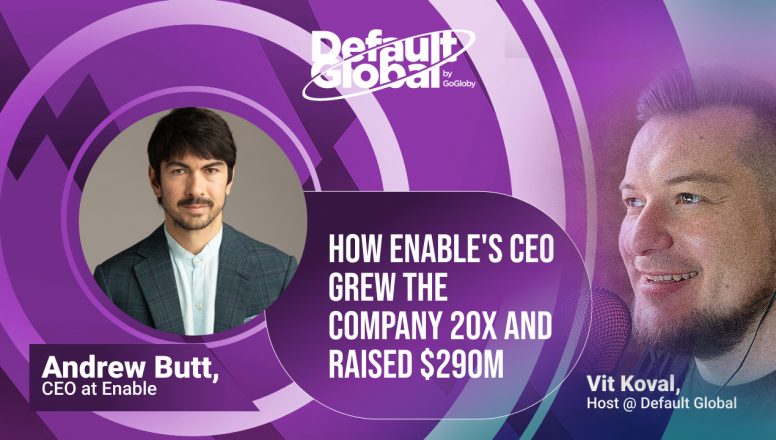Meet Kelsey Bishop, Founder at Candor:
Kelsey Bishop is the Founder of Candor, a company that helps people find belonging at work. Kelsey’s personal experience of the importance of culture fit in her own happiness at work led her to start Candor two years ago. Candor is a product that allows people to create a profile that shows how they work, including their values, work style, and other important information for effective teamwork. Candor is mostly used by remote teams looking to build deeper relationships with their teammates. Kelsey leads a remote team of nine across seven countries and focuses on bringing Candor to as many people as possible.
Listen Up: Kelsey Bishop, Founder at Candor, Full Podcast Episode on Spotify
Watch Now: Kelsey Bishop‘s In-Depth Talk with Vit Koval
Quick Read: Kelsey Bishop, Founder at Candor, Interview Highlights
How does Candor approach hiring for cultural fit when employees are located worldwide?
Kelsey explained that Candor takes a two-pronged approach to assessing cultural fit: defining their company’s core values and conducting a mutual assessment work trial. The company first defined five core values by asking employees to describe behaviors that were celebrated and those that weren’t. Candor then created a rubric for each value, outlining expected behaviors during a work trial period. For example, one value is to be direct and transparent, and behaviors Candor looks for include speaking up in team meetings and giving feedback. Kelsey explained that Candor also looks for behaviors that don’t fit their values, such as not speaking up when one has something to say or being too aggressive with presenting views.
When asked about ensuring openness in company culture, Kelsey shared that her company is an asynchronous culture that heavily relies on open spaces like Slack and Notion for most of their communication. Kelsey also mentioned the importance of putting documents and conversations in public channels to foster transparency and discouraging too much use of direct messaging. The key caveat, however, is that openness and transparency should never override kindness and assuming the best intentions in one another. Kelsey stressed the importance of maintaining a balance between the two, which is a core part of her company’s cultural mold.
How do you maintain that level of autonomy while working with remote guys?
Autonomy is a significant factor in Candor’s company culture, according to Kelsey. To maintain this level of independence, Candor has taken an unusual approach to management, eliminating it entirely. As Kelsey points out, the lack of managers can be daunting for new hires, but the company is upfront about this from the outset. Candor employs a work trial to help employees acclimate to the culture of self-direction. The company encourages employees to trust their instincts, even if it means making a mistake. Kelsey emphasizes that Candor values autonomy but acknowledges that it is a balancing act to prevent employees from becoming too reliant on the perspectives of others.
To overcome this, Candor has implemented synchronous hours between 9 am to 2 pm EST. Everyone is expected to be online during this time, even if they are not in a meeting. This system ensures that the team can check in with each other when necessary, but without slowing down or micromanaging their work. Kelsey notes that Candor’s emphasis on autonomy has led to a culture of trust, which values individual initiative, but she also points out that the company prioritizes kindness, ensuring that employees assume the best intentions of each other.
In summary, Candor’s culture of self-direction, lack of managers, and synchronous hours have created a system that values independence while still providing support and collaboration when necessary. The company’s focus on autonomy, trust, and kindness has helped build a culture where employees feel free to take the initiative and make decisions without fear of retribution, ultimately leading to greater success and job satisfaction.
What is the number of stages in your interview process?
Kelsey’s process involves a vibe check and culture alignment check with Kelsey on a 30-minute call. Kelsey then asks questions about the candidate’s growth and projects they’ve owned from start to finish. There is an hour-long technical take-home assessment for technical roles to evaluate the candidate’s technical skill set. If everything checks out, Kelsey offers a work trial where the candidate is made a contractor for two weeks or longer if they have a full-time job. The candidate is given tasks to complete and is plugged into the company’s Slack channel and team meetings. Kelsey explained that this process has worked well for them as it gives a fair assessment of the candidate’s skills, culture fit, and performance, which is not always possible through traditional interviews.
Kelsey said, “It gives us the sense of, is this the person we want in this role? Is it working as we imagined? And it’s not hypothetical, right? It’s not like I’m asking you a hypothetical interview question: What would you do in this specific scenario? No, like, I’ll just give you a task. And let’s see, let’s see your performance on it. So in that way, it feels a little bit more fair, and it feels more cut and dry.”
Kelsey also explained that the work trial has worked well for the candidate’s side too, as senior candidates want to know if they fit into the company’s culture, which is one of the most important things to sense, and it is hard to do so through a traditional interview process. The work trial gives the candidate a real sense of the day-to-day job and helps them make an informed decision.
Kelsey said, “We’ve had so many people get to the end of a work trial and say, Hey, like, this didn’t really work for me. And, you know, thanks so much for like, I’m going to move on. And that’s actually the best case scenario.”
Do you see any differences in terms of cultural aspects?
As a US-based company, Kelsey mentioned that they have American HR policies, which are not necessarily applicable in other countries. For example, employees in the UK found the company’s vacation policy to be under standard compared to what they were accustomed to. However, Kelsey explained that they tried to normalize policies and benefits by adhering to US standards to avoid feeling out of sync.
Regarding compensation, Kelsey emphasized that they do not adjust salaries based on the employee’s location. Instead, they pay salaries based on US standards, which may not be at par with what employees in other countries expect. To manage local holidays, Kelsey suggested that employees should mark their national holidays on the calendar to avoid confusion within the team.
When asked about measuring success for remote employees, Kelsey emphasized the importance of team-wide goals and individual performance.
She stated, “if say, an engineer has an off month and doesn’t ship their expected thing, then we don’t hit our team wide protocols, right?”.
On the topic of tracking cultural aspects within remote teams, Kelsey mentioned that the culture check is more qualitative at the moment. Her team gets together in person every quarter in different locations, which provides a great opportunity for a culture check. Kelsey believes that this in-person time is an important pulse check for culture and team dynamics.
Global hiring can bring diversity to the workforce, but it also requires companies to navigate the cultural differences across different countries. Companies like Kelsey’s are trying to standardize policies and benefits to avoid confusion while also respecting local customs and holidays.
How do you prioritize communication in public collaboration among team members based in different time zones in different locations?
Kelsey emphasized the importance of using the right tools and strategies. Specifically, Kelsey recommended using Slack for communication and Notion for larger documentation. Kelsey also mentioned the importance of understanding each team member’s communication preferences, especially when it comes to giving feedback. To address this, Kelsey suggested using a tool like Candor to create a profile of each team member’s communication style, including their preferences for receiving feedback. As Kelsey pointed out, understanding these nuances can be crucial when it comes to building a successful remote team.
“Having those nuances of what your teammates really prefer when it comes to work style, I’ve found is really helpful,” Kelsey said. “So having something like a candor profile where I can see… what your teammate enjoys best when it comes to communication, and especially when it comes to feedback… is really important.”
So how do you ensure that your employees do not burn out while maintaining high productivity?
Kelsey noted the advantages of self-regulation in a self-managed team. Without a traditional manager to intervene, employees must take responsibility for monitoring their workload and recognizing when they need a break. Kelsey also highlighted the importance of openness in the team culture, where colleagues feel comfortable calling out each other and encouraging breaks when necessary.
Kelsey’s approach to remote team management emphasizes the significance of team culture and self-regulation in maintaining a fast-paced work style without burning out. As more companies continue to adopt remote work, these insights could prove invaluable in building a successful remote team.






